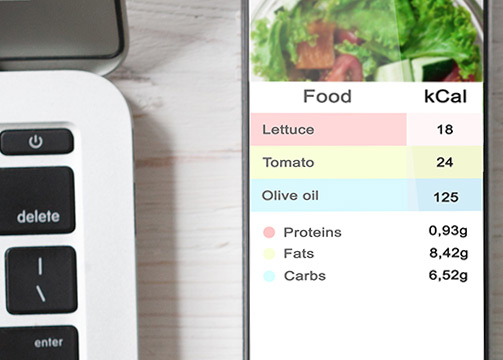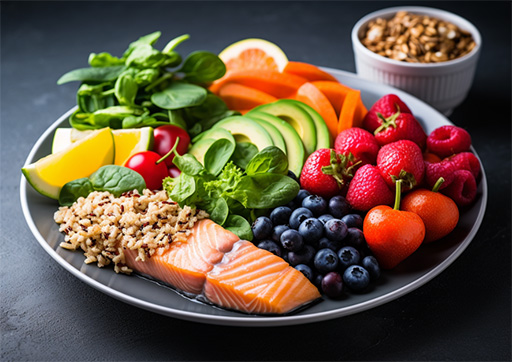Help Patients Improve The Quality Of Food Consumption

Every living thing requires nutrients to survive and thrive. When the body needs nourishment, the brain triggers the body to feel hungry. These hunger pains signals the body that it needs food to get those nutrients. Unfortunately, many times, your patients’ foods are not the best foods that provide the optimal nutrients. The result is a poor diet that leads to health problems.
Calories and Food Consumption
The body requires fuel to move. Even a body that is resting or sleeping requires energy because body systems continue to function at rest. Breathing, digestion, heart beating, etc., are all activities that need fuel to support them. The power comes from the foods we eat. All foods store energy that is measured by calories.
For example, a food item that contains 200 calories means that if your patient eats that, his body will get 200 units of energy that his body can use. Suppose your patient consumes many more calories than what he can typically use up in his daily activities. In that case, eventually, your patient will gain weight because that extra unused energy in his body will be stored and turn into fat.
The average number of calories that a typical adult requires is about 2,000 calories per day. That is a rough average because each person is different. The specific amount that your patient needs will depend on how old your patient is, the gender, the level of activity that your patient engages in every day, and other factors. Men typically require more calories than women. If your patient exercises a lot, he will need a higher number of calories than the average person.
One of the first things you should do when reviewing the food consumption of your patient is whether the number of calories consumed every day is appropriate for the level of physical activity that your patient may or may not engage in.
A Balanced Diet
Calories are a measure of energy in foods. However, the energy stored in food is only one aspect of food. The other aspect is the nutrients that the food item contains. Some fast food is very high in calories but have very few nutrients. So, if your patient eats many foods like that, he risks storing up an excessive amount of energy that he cannot use up, which will turn into fat, and he gains minimal nutrients that will nourish his body.
A diet that is considered balanced provides the body with the nutrients that it requires for it to function correctly. Different categories of foods supply additional nutrients. The types of foods should contain fresh vegetables, fresh fruits, nuts, legumes, whole grains, and lean proteins in a balanced diet. If one of these categories is missing from the foods that your patient typically eats, he risks not getting certain nutrients that his body needs.
A Healthy Plate
A balanced diet should keep your patient’s glucose level even. Certain foods make the glucose level spike, so it is best to avoid those.
You can help your patient visualize what a healthy plate is by using a diagram. Using a circle as the plate, draw a line in the middle to divide the circle in half. Half of the circle should be labeled “fruits and vegetables.”
For the other half, divide that into two quarters. Label one of the quarters “whole grains.” Label the other quarter “lean proteins.”
The half-plate of fruits and vegetables should include a variety of different colors. Potatoes are a root vegetable, but because of their high starch content, and starch turns into sugar, they can cause glucose levels to spike. Recommend to your patient to eat potatoes sparingly.
Whole grains mean each grain is the entire grain with all its parts. Bread and pasta made from whole grain are more nutritious than products made from processed grains.
Lean proteins include fish, poultry, beans, and nuts. Red meats are high in saturated fats, so advise your patient to eat that in moderation.
Although not on a healthy plate, healthy vegetable oils can be part of your patient’s diet. Oils from olives, sunflower, and canola are several examples of healthy oils. Advise your patient to stay away from partially hydrogenated oils because they contain trans fats, contributing to all kinds of severe problems like heart issues, strokes, and type 2 diabetes.
When helping your patient modify his diet for better nutrition, help him ease into the changes, so the healthy diet plan becomes a natural part of his life.

Food Consumption Affect Our Body And Mind
The foods we eat affect the health of the physical body, but they affect mental health as well. Some foods have natural chemicals that trigger a positive reaction in the mind. For instance, chocolate has a reputation for making people happy.
Chocolate contains certain compounds that trigger the brain to release endorphins, a chemical in the brain associated with feeling happy. Other brain chemicals can also be triggered, like tryptophan, a “feel good” neurotransmitter, and phenylethylamine, a brain chemical associated with love.
Why Most Diets Do Not Work
A lot of diets fail because the patient cannot sustain them. Traditionally, dieting requires the patient to give up certain kinds of unhealthy food consumption, usually junk food. However, it is easier said than done. Not indulging in a favorite food at all can create a lot of pent-up food cravings. In a moment of weakness, this pent-up craving can explode and result in the patient gorging on what he was not supposed to eat.
Instead of eliminating a particular food or snack, a better approach would be to advise your patient to cut back on certain foods gradually. For example, if your patient typically indulges in a big slice of chocolate cake after dinner every day, have your patient reduce the size of the piece by half next time. Instead of eating cake for dessert every day, instruct him to eat it just a couple of times a week.
Allowing the patient to include a much smaller portion of his favorite foods or desserts in his diet will reduce the likelihood of a pent-up demand that leads to the patient gorging. It will also make the diet more sustainable because your patient can still enjoy the foods he likes to eat, only in much smaller portions.
Assessing The Nutritional Level Of Your Patient’s Diet
Reviewing your patient’s nutritional levels should be part of the regular check-up. When you test healthy levels, you can identify any nutritional deficiencies in your patient’s body. Nutritional deficiencies are often the first cause of many types of health problems.
They weaken the body’s immunity to become more vulnerable to illnesses and stress and not heal itself. If your patient seems to get sick a lot, it is a good idea to do a nutritional analysis to see if common nutritional deficiencies are causing the root of the problem.
The Food Consumption Questionnaire
One way to find out about the current diet of your patient is by having him fill out a food frequency questionnaire. There should be questions about sizes of the servings, how often the patient eats over some time, the type of food eaten, what the patient prefers to eat, and more.
It also covers food habits, like how often does your patient snack, how often does he cook at home versus how often he goes out to eat, how often does he shop for groceries, the kinds of beverages consumed and includes alcohol, and so forth. These lifestyle questions around food consumption provide a complete picture of how your patient’s food intake affects his health.
The data that you collect from this questionnaire can give you an idea of the level of nutrition that your patient is at and provide clues to the general health of your patient. The quantity and type of food eaten will give you an idea of your patient’s average daily caloric intake.
From the type of foods that your patient says he usually eats, you can determine the level of unhealthy fat and salt that he consumes every day. The questionnaire is just one of many forms of evaluation you can do to get a complete picture of your patient’s nutritional health.
Nutritional Support With Supplements
Helping your patient modify his diet to make it more balanced is necessary, but it may take some time for that deficiency to reach normal levels by just changing the diet. If the deficiency is not corrected sooner, it might manifest into a severe health problem. To give your patient an immediate boost, you may consider a nutritional supplement for your patient.
When you determine which supplements will help your patient the most, adding that to your patient’s daily dietary protocol will improve your patient’s health more quickly. When the body is nourished, it becomes healthier and can stand stronger against illnesses. Your patient’s body will be more capable of healing itself.
How The BioScan System Can Help

If you have patients who are hesitant about undergoing many tests and lab work, you can reassure them that the BioScan system is entirely non-invasive and there is no pain at all. The results are color-coded and easy to understand. You can help the patient understand his health more by explaining the results of the report to him.
If there are areas that require attention, point those out to him and explain how modifying his food consumption can help improve these areas. When the patient returns to you for his next visit, you can have your patient go through the BioScan tests again and see if his results have improved.
You can also use these new results to make any modifications to your previous instructions if necessary. Using this approach, you can help your patients adopt better eating habits and empower them to control their nutritional health.
